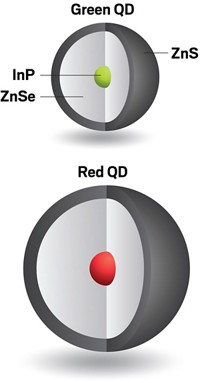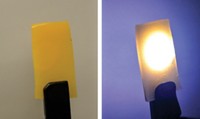Advertisement
Grab your lab coat. Let's get started
Welcome!
Welcome!
Create an account below to get 6 C&EN articles per month, receive newsletters and more - all free.
It seems this is your first time logging in online. Please enter the following information to continue.
As an ACS member you automatically get access to this site. All we need is few more details to create your reading experience.
Not you? Sign in with a different account.
Not you? Sign in with a different account.
ERROR 1
ERROR 1
ERROR 2
ERROR 2
ERROR 2
ERROR 2
ERROR 2
Password and Confirm password must match.
If you have an ACS member number, please enter it here so we can link this account to your membership. (optional)
ERROR 2
ACS values your privacy. By submitting your information, you are gaining access to C&EN and subscribing to our weekly newsletter. We use the information you provide to make your reading experience better, and we will never sell your data to third party members.
Photonics
Blue perovskite LEDs get an efficiency boost
Researchers mix nanoparticles and 2-D perovskites to double efficiency
by Prachi Patel, special to C&EN
August 21, 2019

Perovskites, known for their potential use in solar cells, also hold promise for making low-cost, flexible light-emitting diode panels for lighting and displays. One hurdle that perovskite LEDs face is that blue-light-emitting devices have lagged behind their red and green counterparts in terms of efficiency, and all three colors are crucial for displays and white light. Now, by combining perovskite nanoparticles with 2-D perovskites, researchers have doubled the efficiency of blue LEDs (Nat. Photon. 2019, DOI: 10.1038/s41566-019-0505-4).
The device only glows for a few minutes, but the work is “a big step toward the development of high-performance blue perovskite emitters,” says Jianjun Tian of the University of Science and Technology in Beijing, who was not involved in the work. “The efficiency of these blue perovskite LEDs is already higher than that of the commercially available blue organic LEDs.”
Since researchers reported the first perovskite LED five years ago, the efficiency of red and green devices has increased from 1% to over 20%. But the blue ones have been a different story.
Getting efficient blue emission has troubled all LED technologies. In fact, the 2014 Nobel Prize in Physics was awarded to scientists who invented efficient blue LEDs. The physics of how LEDs work contribute to the struggles with blue devices. Applying an electric potential to LED materials excites their electrons, and when those excited electrons fall from a high energy level to a lower one, light gets emitted. The gap between these levels, also called the bandgap, dictates the color of the light. To produce blue light, that bandgap needs to be very large. But materials with large bandgaps usually have more defects that trap electrons, blocking light emission and dragging down efficiency.
Perovskites have their own blue-light issues. Researchers have typically made blue LEDs with metal halide perovskites by mixing bromide and chloride compounds and tuning their ratio. But the color slowly changes as the halides in the compound separate. Another promising approach is to use nano-sized bromide-based perovskites such as quantum dots, which are highly efficient at converting excited electrons to light. But scientists have struggled to get enough electrons into the tiny quantum dots, leading to dim emitters, says Yizheng Jin of Zhejiang University in China.
Jin and his colleagues solved these issues by making films of lead bromide perovskite nanoparticles embedded in a matrix of 2-D perovskite layers. The 2-D perovskite has a large bandgap suitable for blue emission, but also electron-trapping defects. However, in the new films, nearly all of the excited electrons from the 2-D perovskites pass into the nanoparticles, leading to blue emission at a wavelength of 483 nm. As a result, the efficiency of these blue LEDs is 9.5%. Commercial blue organic LEDs have an efficiency of about 5%.
This approach is important progress, but there is still a long way to go before blue perovskite LEDs can be practical, says Qihua Xiong, a physicist and electrical engineer at Nanyang Technical University. The light emission needs to be much brighter, and the devices should be much more stable, he says.
Right now, the devices have a brightness of 100 candelas per square meter; computer monitors and TV screens require at least 300. And the LED’s efficiency drops by half after shining for only four minutes. The short lifetime of perovskite LEDs is one of the most challenging hurdles to commercialization, Jin says. “Even for the most efficient green and red devices, the lifetime is limited to less than 200 hours,” he says. Commercial LEDs need to last 10 or more times longer.
Jin and his colleagues plan to investigate the mechanisms behind efficiency loss and experiment with different material chemistries and nanostructures to increase efficiency and lifetime.
Instability also plagued early perovskite solar cells, Tian points out. Given the encouraging recent advances on the stability of perovskite solar cells, he says, “I am optimistic on the future of perovskite LEDs.”





Join the conversation
Contact the reporter
Submit a Letter to the Editor for publication
Engage with us on Twitter